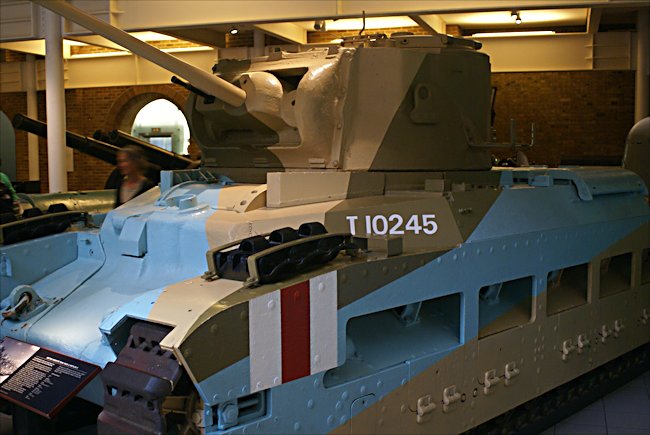The Matilda II British Infantry Tank A12 MkV
This Matilda II British Infantry Tank A12 MkV used to be on display at the Imperial War Museum London up until 2014. It is now in storage at the Imperial War Museum Duxford

Within the British 1st Army Tank Brigade three battalions of the Royal Tank Regiment were equipped with the Matilda II tank, consisting of the 4th at Farnborough, the 7th at Catterick and the 8th at Perham Down on Salisbury Plain. Unfortunately, the only unit ready to be shipped to France in 1939 was the 4th.
Production of the Matilda II tank was agonisingly slow. This was a tank that could have stopped the German blitzkrieg, if it was available in enough numbers. The only German weapon that could pierce the 78mm armour on the front of the Matilda II was the German 88mm anti-tank gun.
The Matilda II MkV Tank differed from earlier variants by having an improved gear box and an upgraded Westinghouse air servo fitted. The Matilda Tank was the British Army's most successful tank in the opening campaigns of the Second World War. It was designed as an infantry support tank rather than a fast maneuverable cruiser tank. Its slow speed was compensated by thick armour and a 2pdr gun capable of dealing with most German and Italian tanks of 1940 - 1941.
Development began in the 1930's and the first batch of Matilda II tanks entered service in September 1939 just in time for the start of WW2. The Matilda Tank performed with distinction during the Battle of France in 1940. It really proved its worth in the western desert campaigns of North Africa. It dominated the battle field for almost a year but in 1941 better German weapons appeared on the battlefield that could stop and destroy British Matilda II tanks. The Africa Korp's 88mm Flak Gun made the Matilda appear slow, undergunned and inadequately armoured. The small turret ring meant that a bigger gun could not be fitted to the tank. The Matilda had to be withdrawn from active service in 1942. It was replaced by the M3 Grant, M3 Lee and M4 Sherman tank.
Some Matilda Tanks were converted into flame throwers or mine clearing variants. Others were sent to Russia and the jungles of New Guinea. This tank in the photograph never saw action. It was used as a training tank by the Royal Armoured Corps Training Regiment in Britain.
The MKIII version of this Matilda II meant that it had a new Leyland diesel engine fitted in place of original AEC engine. The Camoflaugfe mpattern is called 'Caunter' and was to meant for fast Cruiser tanks as it was probably meant to confuse the exact position of a tank at the head of the dust storm they always created in the desert. It was painted on slow heavy Matilda II tanks but they were probably too slow to benefit from this scheme.
A Matilda II tank crew find Rommel in a shell hole
During the unsuccessful British counter-attack around the village of Wailly by the 7th Royal Tank Regiment in May 1940, Panzer General Erwin Rommel had to take cover in a shell hole with his radio operator. A British Matilda II infantry tank was advancing towards them. It cornered them in the crater without any means of fighting back.
Rommel had just rushed back from the front to personally deal with this flanking attack. He had successfully used a battery of 88mm guns to stop most of the advancing British tanks. The Matilda crept towards the General. Rather than advancing to shoot Rommel or take him prisoner, the British tank crew jumped out of the tank and gave themselves up when it finally halted.
The tank’s driver had been mortally injured and the tank ground to a halt when he died. It was Rommel’s lucky day. He went on to marshal the rest of the German troops who had been thrown into confusion and panic when the British counter-attack first hit their lines. One has to ask, "What if…?"
WW2 tank books

